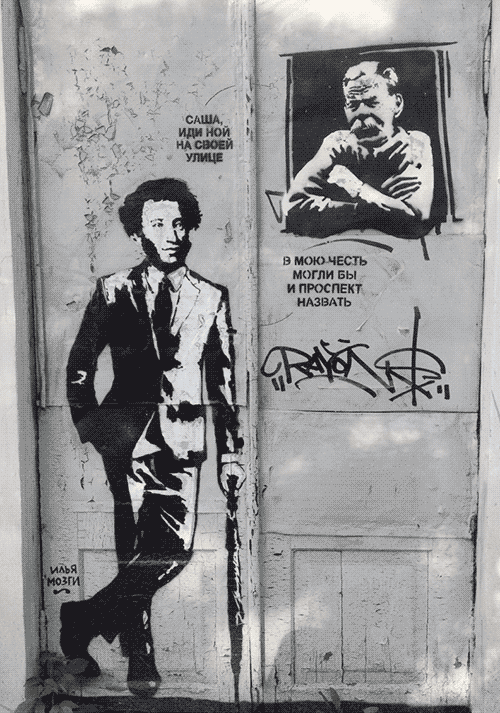What do Americans see when they look at the faces of Dzhokhar and Tamerlan Tsarnaev? And do Russians see the same thing?
One of the many instructive ironies surrounding the intense speculation about the Boston bombings involves the racial identity of the suspects: from the elusive "dark-skinned male" and David Sirota's hopes that the bomber would prove to be a "white American" to the identification of the Tsarnaev brothers as the alleged culprits, the American media and blogosphere have puzzled over the extent of the men's whiteness. As Peter Beinart puts it on The Daily Beast, "Are the Tsarnaevs White?" Before the Tsarnaevs were fingered as the culprits, the various approaches to their race were so simple as to need virtually no analysis. In the absence of data, all we had were preconceived notions about race, crime, and terror. Watching these discussions was like watching America's racial unconscious talk to itself--facts would only get in the way.
But when the "facts" arrived (and here we should remember that the Tsarnaevs have been accused, not convicted), they merely exposed how little facts matter in questions of whiteness. Beinart does a fine job reminding us that whiteness has long been a historically constructed and contested category in America, one that cannot be reduced merely to skin tone.
The history of immigration and assimilation in the United States is one of varying degrees of recasting whiteness. As recently as 1988, I remember a limo driver in southern New Jersey explaining to me that Princeton was so ritzy "you had to be white or Italian to live there." The Italians, Irish and Jews eventually overcame enough stigma to be considered white, but they were not "white" from the very beginning. The color line is still decisive: visible shades of brown or gold are an insurmountable impediment.
Beinart's conclusion is that the obstacle to the Tsarnaevs' whiteness is Islam, which in contemporary America has the effect of adding invisible layers of brown to otherwise pale skin. This makes sense as far as it goes, but leaves out a crucial component for understanding the Tsarnaevs' position on the color wheel: their racial identity before their arrival in the United States. Back in the Russian Federation, were the Tsarnaevs "white"? And if they weren't, what were they?
Billngual speakers of Russian and English all recognize the disconnect between the terms "Caucasian" (i.e., "white") and "Caucasian" (person from the Caucasus region of the former Soviet Union); for Russian speakers, the two terms are functionally opposite. What, then, are "people of Caucasian nationality" (as the Russian bureaucratic phrase would have it)? Can their difference be mapped on to a grid of whiteness and non-whiteness?
Part of the problem in mediating between American and Russian understandings of difference is that Americans are so accustomed to seeing race as the default category for otherness that we take its universality for granted. Of course, decades of post-structuralist and post-colonial studies have argued this very point, but often in prose whose god-awfulness gives the general public a free pass from engaging with it. The American preoccupation with race as a primal category makes complete sense, given that the country is haunted by not one, but two racial original sins (native American genocide and the enslavement and mass murder of Africans and their descendants). The power of American racial discourse threatens to suck the life out of other analytic categories; in the public sphere, the only way we can even broach issues of social class is to conceive of them as issues of race.
Russia is another matter entirety. Social class is not a taboo topic, and the notion of "race" has played itself out quite differently. Scholars of the (post-) Soviet Union traditionally ignored the very category as irrelevant (though that has started to change in the past decade). Russian discourses of race overlap with their American counterparts, but only in part. Rather, race in Russia functions within the much more common category of "ethnicity" or "nationality."
On the one hand, ethnic Russianness is certainly ascribed a default whiteness, but this does not necessarily translate to Russians thinking of themselves primarily as "white." Instead, the equivalent to the American understanding of "Caucasian" is "European." Whiteness is invoked conversationally as a function of status and comfort, with a casualness that would cause their American interlocutors to, well, blanch. Jennifer Patico provides an example of a common Russian expression when she tells of a woman who is proud of her improved housing accommodations: "we are now living like white people." Here whiteness points to the speaker (who is, of course, white) in an unselfconscious fashion that would be impossible in the United States: whiteness without guilt.
In the absence of a significant population of descendants from Africa, race and color cannot play themselves out along American lines. The former empire's vast Asian population can be and is understood in racial terms, but is spoken of more often in terms of ethnicity and even civilization. Here Russia's own preoccupation with geography trumps America's preoccupation with race: Russia has historically been far more concerned with its status as Eastern or Western, Asian or European, than it has with color or "scientific" understandings of race.
This does not mean that no one in Russia is "black." The Russian word for "black" has recently started to be applied to people of African descent, (as part of a compound term, "black-skinned"), but only as a reluctant adoption of American terminology and in the face of English speaker's discomfort with "negr", the traditional Russian term. The reluctance stems from the fact that "black" as a categorical descriptor of human beings is, in Russian, negative by definition. And it is applied not according to skin color, but to hair color: in Russia, the "blacks" are the people from the Caucasus. That is, the "Caucasians," and anyone who might look like them.
When I'm in Moscow, I expect to be stopped by police and asked for my documents on a fairly regular basis. With the protection of my magical American passport, I usually treat it as something of a sport, baiting younger, Chechen-hunting police officers who have lost the Soviet-era knack for spotting a Jew. But the time that I did not have my passport with me, I was almost taken to the local precinct for processing, while the cop who detained me kept asking me pointed questions about my "ethnicity." By the end, he excused himself by saying, "I'm sure this kind of thing happens in your country all the time." I wanted to tell him, "No, it doesn't," because I didn't want to let him off the hook so easily, but I realized that a more truthful answer would be, "It doesn't happen to white people." And that was the point: I was experiencing contradictory definitions of whiteness while sitting in a Russian police van. To be clear: the amount of sympathy a privileged white American should be able to get from this incident is exactly zero. But I do find it enlightening.
All of this brings me back, finally, to the Tsarnaevs and the multiple ironies of border-crossings. Just as Soviet Jews, who were not Russian by definition, became "Russians" in America, it is only by coming to the United States that the Tsarnaevs became fully white. And in the process, reminded us once again of just how tenuous the category actually is.



